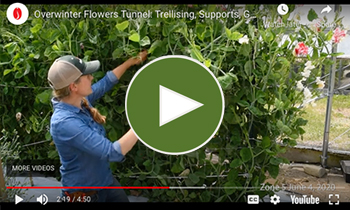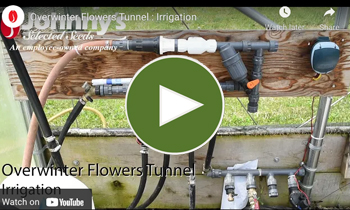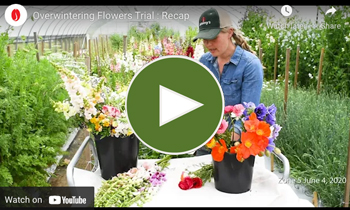- 3 Easy, Reliable, Productive Cut Flowers: Sunflowers, Zinnias & Rudbeckia
- 5 Factors That Determine Vase Life of Cut Flowers
- 2019 American Flowers Week: Combining the Art of Floral Design & Couture
- Celebrate the 7th American Flowers Week | Johnny's 2021 Botanical Couture
- Celebrating the 8th American Flowers Week | Johnny's 2022 Botanical Couture
- Collective Selling Models for Flower Farmers: Flower Hubs That Work
- 5 Cool Flowers to Plant Now | Lisa Mason Ziegler's Secrets for Growing Hardy, Cool-Season Annuals
- Cut-Flower Harvesting & Post-Harvest Care | Best Practices from Pros in the Slow Flower Community
- Cut-Flower Kit | Guide for Market Growers (PDF)
- Easy Cut-Flower Garden Map | For Growers New to Flowers (PDF)
- Easy Cut-Flower Garden Planner | For Growers New to Flowers (PDF)
- From Color to Climate: 5 Floricultural Trends Subtle & Seismic
- Flower Culture by Crop | Comparison Chart | Days to Germination, Weeks to Transplant, Days to Harvest (PDF)
- Flower Farmers' Favorite Fillers & Foliage | Recommendations from 3 Farmer-Florists
- Getting Started in Cut-Flowers | Top 15 Cuts
- Heat & Drought: How Flower Farmers Are Adapting to Changing & Challenging Climatic Conditions
- Introduction to Overwintering Flowers | Guide to Overwintering Flowers
- An Introduction to Producer Marketing Cooperatives | M Lund & Associates
- How Day Length Affects Cut-Flower Production
- Growing Flowers in Hoophouses & High Tunnels: Cool-Weather & Hot-Weather Options
- Starting a U-Pick Flower Farm, From A-to-Z
- Growing Flower Seedlings for Profit
- Roadside Flower Stand Basics: Success Tips for On-Farm Retail
- Year-Round Flower Production Strategy
- Overwinter Flower Trials | Multiyear Results for 30+ Crops | Johnny's Selected Seeds | XLSX
- Seeding Date Calculator | Johnny's Recommended Flowers for Overwintering | XLSX
- Pricing & Profitability for Flower-Farmers | Pointers from a Diversity of Pros
- Sustainable Farming Methods | A Survey of Flower Farmers' Best Practices
- Just Add Flowers | An Introduction to Companion Planting for Vegetable & Herb Gardeners
- Slow Flowers Palette & Petal Crushes | Evolving Colors & Shape-Shifts in Floral Industry Trends
- Johnny's and Slow Flowers | Johnny's Selected Seeds
- Slow Flowers | Celebrating Fifth-Season Regional Design Elements
- Slow Flowers Floral Forecast | A Summary of Industry Insights & Trends
- Building a Better Market Bouquet: Tips, Techniques & Recipes for Flower Farmers
- Slow Flowers | Tips for Staging On-Farm Floral Workshops | Johnny's Selected Seeds
- Wedding Wisdom 101 | 10 Beginner Tips for Entering the Wedding Floral Landscape
- Succession-Planting Flowers | Scheduling & Planning, Sowing Frequency, Recordkeeping & Recommendations
- Succession-Planting Interval Chart for Flowers
- Sustainable Floral Design | Techniques & Mechanics for Foam-Free Floristry | Tobey Nelson & Debra Prinzing
- Video: Mason Jar Bouquet Tutorial
- Video: How to Build a Bouquet
- Video: Tobey Nelson | Sustainable Floral Design | Slow Flowers Summit
- Video: Economic Considerations in Overwintering Cut Flowers | Johnny's Selected Seeds
- Top 10 Cut-Flower Varieties for Direct Seeding
- Video: Floating Row Cover | Baby "Cool Flower" Protection from Whipping Winter Winds
- Video: The Procona System for All-in-one Flower Harvest, Transport & Display
- Johnny's Overwinter Flowers Tunnel: Trellising, Supports, Ground Cover & Spacing
- Video: Irrigation Considerations for the Overwinter Flowers Tunnel | Johnny's Selected Seeds
- Video: Johnny's Overwinter Flowers Trial Recap
- Video: Producer Cooperatives for Small-Scale Farmers | Johnny's Webinar Series
- Climate Adaptation for Vegetable & Flower Farmers | Johnny's Educational Webinar Resources
- Chrysal CVBN Flower Conditioner | SDS
- Webinar Slide Deck | New-for-2023 Flowers & Floral Supplies | PDF
- Chrysal Clear Bulb Flower Conditioner | SDS
- Chrysal Professional 2 Transport & Display T-Bag | SDS
- Chrysal Classic Professional 2 Transport & Display (Holding) Solution | SDS
- Chrysal Clear Universal Flower Conditioner | SDS
- Webinar Slide Deck | Flower Growing in Southern States | PDF
- Choosing Flower Crops to Overwinter | Guide to Overwintering Flowers
- Edible Flowers List: Top 20 Favorites from the Slow Flowers Community
- Floral Standards for Flower Farm Collectives and Cooperatives
- Bloom to Boom: Flower Farm Profitability
- Choosing Tulip Varieties for Forcing | Guide to Forcing Flower Bulbs
- Forcing Tulip Bulbs | Guide to Forcing Flower Bulbs
- Snapdragon Groups Explained
- Flowering in the South: Profiles of 5 flower farmers who cope with temperature, humidity, pest & weed pressure
- Video: Flower Growing in Southern States | Johnny's Webinar Series
- 10 Tips for Building a Profitable Cut-Flower Business
- Introduction to Forcing Flower Bulbs in Soil | Guide to Forcing Flower Bulbs
- U-Pick Power for Your Flower Farm | Johnny's Webinar Series
- Eat Your Flowers: Serve Up That Wow Factor With Edible Flowers
- U-Pick Power for Your Flower Farm | Johnny's Webinar Series
- Flower Growing in Southern States | Johnny's Educational Webinar Series
- Chrysal Clear Bulb T-Bag | Cut-Flower Conditioner | SDS
- Chrysal Professional 1 Hydration Solution | SDS
- Chrysal Professional 3 Vase Solution Powder | SDS
- When to Start Seeds for Overwintered Flowers | Guide to Overwintering Flowers
- Webinar Slide Deck | U-Pick Power for Your Flower Farm | PDF
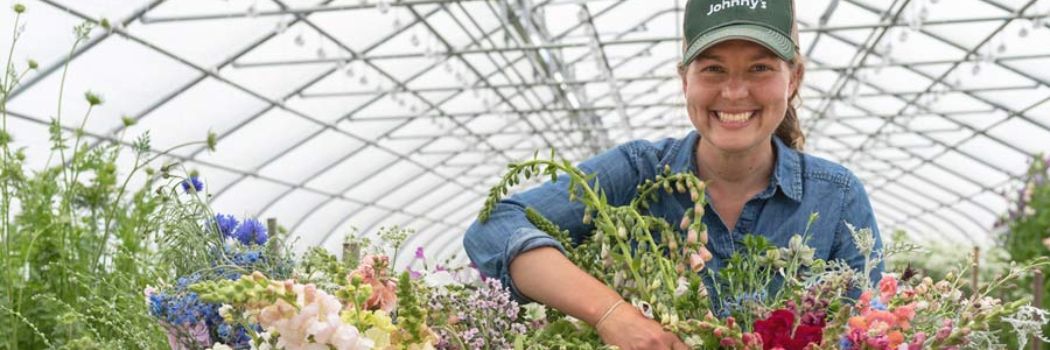
Introduction to Overwintering Flowers: Methods & Recommendations from Johnny’s Multiyear Trials
By Hillary Alger, Flower Product Manager, and Joy Longfellow, Flower Trial Technician, Johnny's Selected Seeds
Guide to Overwintering Flowers
- Introduction to Overwintering Flowers
- Choosing Flower Crops
- When to Start Seeds
Many types of flowers can be started in late summer or fall, for overwintering. We have found that many overwinter crops in our zone/latitude flower about a month earlier than spring-planted field crops (with some variation between varieties), providing an abundance of high-quality blooms long before any field crops are ready for harvest.
Naturally, growers in different locations will experience different results. Some crops will overwinter successfully in your area, while others will not, and results will often vary from year to year as well. Plus, even if a particular flower crop overwinters successfully for you, it may not provide a financially viable opportunity, whereas others may excel in this regard.
For all these reasons, we encourage you to start by conducting your own small-scale trials before scaling up your production plans. Then continue to experiment each year, to see what is feasible and learn more about the limits and possibilities of four-season cut-flower production on your farm.
Preparing Your Unheated High Tunnel for Overwintering
Here are the essential items to consider as you prepare you high tunnel for overwintering flowers.
Mulch
We use a white/black plastic mulch for weed and temperature control. The black on the underside of the mulch provides effective weed suppression and the white on top keeps the roots cooler. Keeping the roots cool is important in the late summer during transplanting, when the days are still long and warm, and in the spring as the days lengthen and the tunnel heats up. Remember: these are cool-loving crops. We also use weed mats in the rows to keep weeds at a minimum.
Plant Spacing
Your plant spacing will vary depending on your production system. For most crops, we space plants at 3 rows per 36” wide bed with 6” spacing between plants. For very vigorous crops such as Ammi, Rudbeckia, etc. we recommend in-row spacing of 12” apart. For efficiency in achieving even spacing, simply lay Hortonova over the garden bed and use it as a planting grid.
Frost Protection
We use hoops and Agribon+ AG-70 row cover over the plants.
Trellising
We find that tunnel plantings produce lush vegetative growth and the plants are typically taller and more vigorous than field plantings, making trellising and crop supports particularly important.
For climbing crops, like sweet peas, we use vertical Hortonova stretched between t-posts and supplemented with twine (also attached to the t-posts).
For more upright crops, we use Hortonova horizontally to provide adequate support.
A Note About Tunnel Production: Most of our overwintered flower trials have been conducted in unheated high-tunnel structures with additional row-cover and hoops inside of the high tunnel structure. It is also possible to overwinter crops in low tunnels or low hoop structures in the field, especially in warmer climates where lighter protection is adequate. We have conducted minimal experiments overwintering flowers under low tunnels or low hoops in Zone 5a and in general we have found the survival rate and overall quality to be a bit less reliable and the crop time to be a bit later under the low tunnel or low hoop structures compared to the same crops overwintered in high tunnels.
Creating an Irrigation Plan
Irrigation in the unheated tunnel can be tricky, so plan ahead. We use 4 lines of drip irrigation on each 36” wide bed. This set up allows us to water-in transplants in the late summer and get the plants well established in the fall. However, once freezing weather hits our Zone 5a tunnels (usually in late November), we shut the water off and don’t have access to water again until the ground thaws sometime in late March or early April.
During the winter months, when daylight drops below 9 hours per day, the plants go into a holding pattern, putting on little growth, reducing transpiration rates, and requiring little water. However, in early spring as the days lengthen, the plants begin to put on vegetative growth and require water. For us, this happens before we can turn on the irrigation system, so we have to bring water out in barrels a couple of times in February and March, depending on the weather. As you plan your system, consider how you will provide your plants necessary water when the ground is still frozen in late winter and early spring.
Typical Schedule for Our Farm
Our Research Farm is located in Central Maine, in Growing Zone 5a, Latitude 44.6°N.
- Late July–mid September
- Sow seeds.
- September
- Prep beds in the tunnels.
- Add organic amendments to soil as normal. Do not use any type of faster-acting fertilizer. You do not want much new top growth now. You want the plants to root out and acclimatize for winter, which takes transplants about 4 weeks.
- October 7–15
- Transplant into beds inside covered structure.
- Seedlings should be about 3–4" tall and have 2 or 3 sets of true leaves at transplanting. If seedlings are too big, pinch off extra height.
- We aim to have our overwinter tunnel planted by the time we plant our field tulips and daffodils in mid-October.
- Install low hoops to support floating row cover.
- November–February
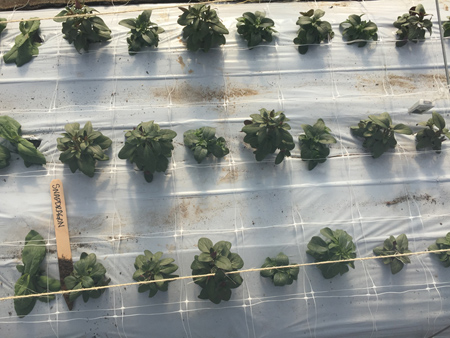 This photo of our overwinter snapdragon trial was taken January 17.Research has demonstrated how plants physiologically adapt to colder temperatures over time. A snapdragon planted in mid October in a tunnel in Maine will develop differently from one that is planted in the field in early May. Changes take place at a cellular level that allow the plant to withstand the cold temperatures and waning light. Plants are more likely to survive winter if they have a well-established root system. Scheduling the sowing date correctly allows the plant enough time to slowly acclimate to the cold, without expending too much energy into vegetative growth that will most likely die off in the winter.
This photo of our overwinter snapdragon trial was taken January 17.Research has demonstrated how plants physiologically adapt to colder temperatures over time. A snapdragon planted in mid October in a tunnel in Maine will develop differently from one that is planted in the field in early May. Changes take place at a cellular level that allow the plant to withstand the cold temperatures and waning light. Plants are more likely to survive winter if they have a well-established root system. Scheduling the sowing date correctly allows the plant enough time to slowly acclimate to the cold, without expending too much energy into vegetative growth that will most likely die off in the winter.
A snapdragon plant that is full-grown going into the winter, in contrast, with a lot of vegetative (top) growth, is more likely to suffer tissue damage and death as a result of the cold winter temperatures. This dead tissue can become an entry point for pathogens during the long, cool, damp winter in the tunnel.
Our goal is to have well-rooted plants without excessive vegetation going into the winter. A deep root system will help keep the growing tips of the plants alive even if there is some leaf and tissue damage on outer foliage due to cold.- Cover crops with row cover when outside temperatures are forecast below 32°F / 0°C.
- Keep seedlings watered, but do not overwater. You should not need to water after the ground has frozen. Plants may require water in the spring before the ground is thawed—consider in advance how your irrigation system will work in your tunnel if the ground is still frozen. In our trials, we have typically had to haul water to the tunnel 1–3 times in late February and early March, when plants start to grow but before the ground thaws.
- Beware of heat or humidity build-up under covers. Be prepared to vent if needed.
- Late February–March
- Monitor for need to water—plants will begin growing as days lengthen and will likely need water before the ground thaws.
- Late March or Early April
- Remove row cover from beds as outdoor temperatures rise and plants grow.
- We found some early crops (Centaurea, Agrostemma) outgrew the height of the low hoops before the rest of the crops in the tunnel. This, along with warming temperatures, determined when we stopped using row cover.
- April–June
- Harvest your blooms!
In our trials, most of the flower crops we overwintered in an unheated hoop house structure flowered about a month earlier and were of much higher quality than those produced in a typical unprotected spring-sown field planting.
But remember, this information is intended to give you a starting point. Your own method and timing may differ depending on your zone, latitude, and the severity of your winters.
5 Fall Steps for Spring Success
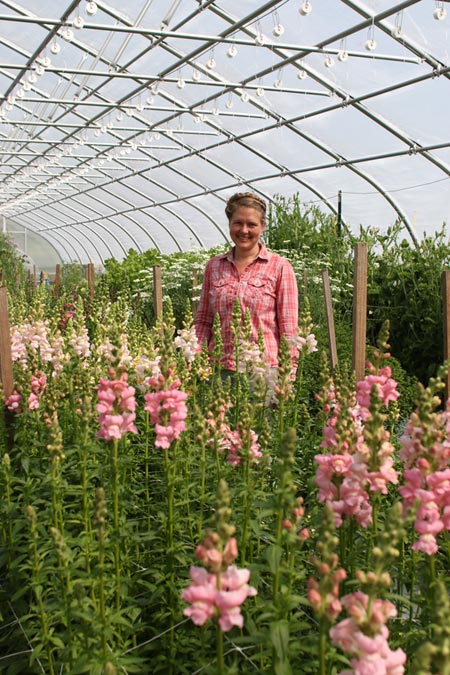
- Though some crops can be direct-sown, for tunnel plantings, we generally recommend sowing seeds in plug trays and transplanting the seedlings, to ensure a full stand in the precious real estate of a covered structure.
- Follow the standard Key Growing Information for germination and growing to transplant size.
- Transplant to prepared beds in a covered structure such as hoophouse.
- Allow about 1 month for seedlings to develop good root systems, before daylength drops below 10 hours/day and the first hard freeze takes place (usually the first week in November for us in Central Maine). For more detailed guidance on identifying your seeding and transplanting dates, read When to Start Seeds for Overwintered Flowers.
- Once outdoor temperatures consistently fall below freezing, install hoops and row cover over the plants within your covered structure, to add protection from frost as necessary. In Zone 5a, for example, we use AG-70, and recommend this heavy weight for other higher-latitude regions. Also take note of the more tender crops requiring a double layer of row cover "blankets" in our Overwinter Flower Trial • Results by Crop spreadsheet.
Learn More
- View all of our flower varieties that are good for overwintering
- Choosing Flower Crops to Overwinter: Results from Our Trials
- When to Start Seeds for Overwintered Flowers
- Overwintering Flowers Webinar • How to extend your growing season with cold-hardy annuals • COMPREHENSIVE RESOURCES
- Overwinter Flower Trials • Results by Crop • XLSX
- Overwinter Flower Trials • Seeding Date Calculator • XLSX
- U.S. Hardiness Zones • MAP


